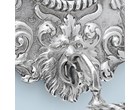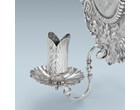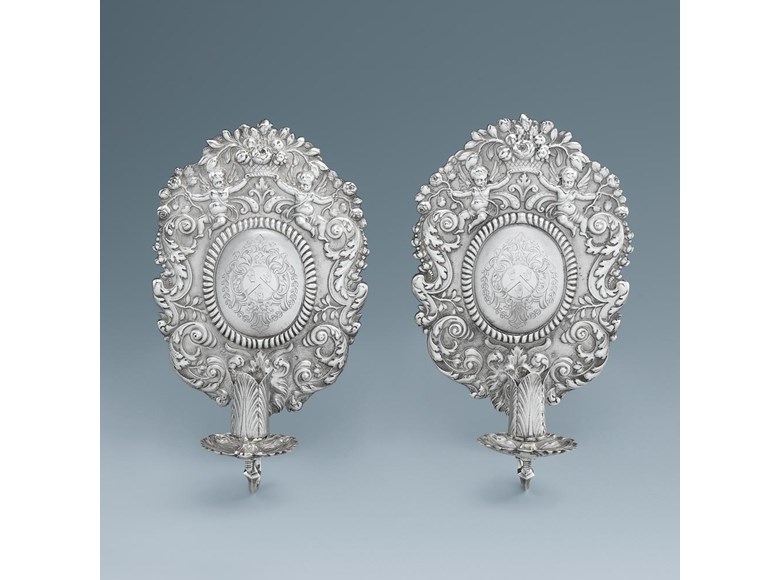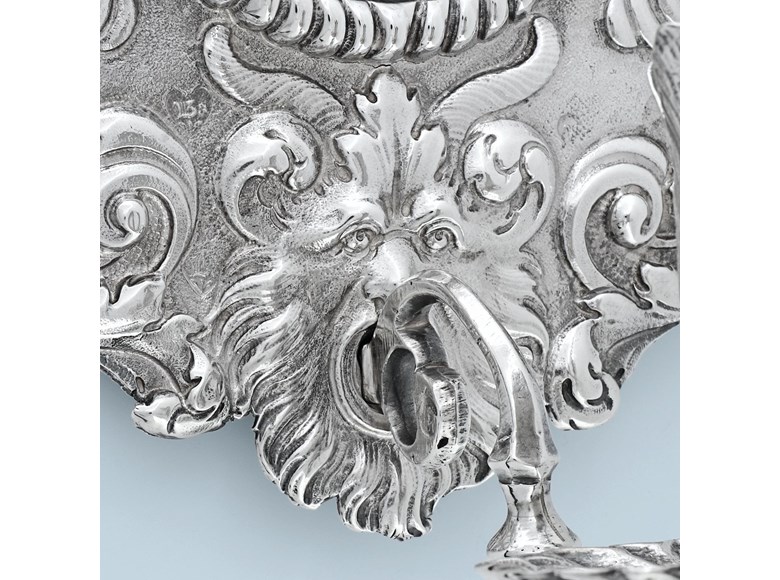 BACK TO GALLERY
BACK TO GALLERY
S.J. Shrubsole
John Barnard
A Pair of William III Antique English Silver Wall Lights
With boisterous Baroque decoration and In exceptional condition.
Height: 10 1/2"
description
The relatively thin sheet metal from which wall-lights were made has, in nearly all cases, been torn, bent, dented or otherwise damaged; one can thus see from the front the losses of detail, and on the back the blocks of supporting metal and solder that have built up over years of use and repair. This is the only pair we have seen with absolutely no damage, and with very little wear from polishing.
The arms are those of Maynard, for Sir Banastre (c. 1642 - 1718), 3rd Baron Maynard of Estaines and Wicklow. In 1665 he married Lady Elizabeth Grey (d. 1714), daughter of Henry Grey, 10th Earl of Kent. He was elected Member of Parliament for Essex to the Cavalier Parliament in 1663, served as Commissioner for Assessment for Essex until 1680, and as Commissioner for Recusants in 1675. Maynard went on to serve as a Justice of the Peace from 1688 until his death in 1718. These sconces may have been made for his succession to the Barony in 1699 following the death of his father.
In 1590 Elizabeth I granted Henry Maynard (1547-1610), great-grandfather of the 3rd Baron, 10,000 acres in gratitude for his service as Private Secretary to William Cecil, 1st Baron Burghley, Lord Chancellor and Treasurer to the Queen. Maynard began construction of an Elizabethan manor, Easton Lodge, in 1597 on the footprints of an earlier hunting lodge on the estate. The original design of Easton Lodge was inspired by Blickling Hall in Norfolk, the birthplace of Anne Boleyn. The Lodge was updated throughout the next two centuries until a great fire in 1847 destroyed the Elizabethan portion of the house. While the Jacobean wing remained intact, the rest of the lodge was rebuilt in the gothic revival style. A second fire in 1918, believed to have been started by one of the Countess of Warwick’s pet monkeys, ravaged the Jacobean wing of the house. The countess rebuilt the Jacobean wing, where she lived until her death in 1938. Following WWII, the Victorian portion of the house was demolished, and in the 1960’s the existing west wing (formerly the Jacobean wing) was sold and renamed Warwick House. The gardens have been open to the public since 1985.
The arms are those of Maynard, for Sir Banastre (c. 1642 - 1718), 3rd Baron Maynard of Estaines and Wicklow. In 1665 he married Lady Elizabeth Grey (d. 1714), daughter of Henry Grey, 10th Earl of Kent. He was elected Member of Parliament for Essex to the Cavalier Parliament in 1663, served as Commissioner for Assessment for Essex until 1680, and as Commissioner for Recusants in 1675. Maynard went on to serve as a Justice of the Peace from 1688 until his death in 1718. These sconces may have been made for his succession to the Barony in 1699 following the death of his father.
In 1590 Elizabeth I granted Henry Maynard (1547-1610), great-grandfather of the 3rd Baron, 10,000 acres in gratitude for his service as Private Secretary to William Cecil, 1st Baron Burghley, Lord Chancellor and Treasurer to the Queen. Maynard began construction of an Elizabethan manor, Easton Lodge, in 1597 on the footprints of an earlier hunting lodge on the estate. The original design of Easton Lodge was inspired by Blickling Hall in Norfolk, the birthplace of Anne Boleyn. The Lodge was updated throughout the next two centuries until a great fire in 1847 destroyed the Elizabethan portion of the house. While the Jacobean wing remained intact, the rest of the lodge was rebuilt in the gothic revival style. A second fire in 1918, believed to have been started by one of the Countess of Warwick’s pet monkeys, ravaged the Jacobean wing of the house. The countess rebuilt the Jacobean wing, where she lived until her death in 1938. Following WWII, the Victorian portion of the house was demolished, and in the 1960’s the existing west wing (formerly the Jacobean wing) was sold and renamed Warwick House. The gardens have been open to the public since 1985.










 SEND AN EMAIL
SEND AN EMAIL
 (212) 753-8920
(212) 753-8920